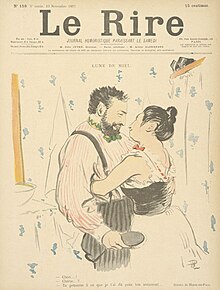Le Rire
- Machine translation, like DeepL or Google Translate, is a useful starting point for translations, but translators must revise errors as necessary and confirm that the translation is accurate, rather than simply copy-pasting machine-translated text into the English Wikipedia.
- Consider adding a topic to this template: there are already 1,436 articles in the main category, and specifying
|topic=will aid in categorization. - Do not translate text that appears unreliable or low-quality. If possible, verify the text with references provided in the foreign-language article.
- You must provide copyright attribution in the edit summary accompanying your translation by providing an interlanguage link to the source of your translation. A model attribution edit summary is
Content in this edit is translated from the existing French Wikipedia article at [[:fr:Le Rire]]; see its history for attribution. - You may also add the template
{{Translated|fr|Le Rire}}to the talk page. - For more guidance, see Wikipedia:Translation.

Le Rire (French: [lə ʁiʁ], "Laughter") was a successful French humor magazine published from October 1894 until its final issue in April 1971. Founded in Paris during the Belle Époque by Felix Juven, Le Rire appeared as typical Parisians began to achieve more education, income and leisure time. Interest in the arts, culture and politics intensified during the Gay Nineties. Publications like this helped satisfy such curiosity. It was the most successful of all the "Journaux Humoristiques."
The Dreyfus Affair occurred in 1894 and Le Rire was one of many publications to tap anti-Republican sentiment in wake of that scandal. It was a time in which French governance was frequently characterized by corruption and mismanagement. Government ministers and military officials became frequent targets.
The satirical journal was filled with excellent drawings by prominent artists. It featured full-page chromotypographs on both covers and in the centerfold. Many of these pieces are now highly desirable collectibles. The most prominent contributor was Théophile Steinlen. His illustrations were biting caricatures of the political "jackasses" of the day. Illustrations were contributed by artists such as Henri de Toulouse-Lautrec, Georges Goursat, René Georges Hermann-Paul, Juan Gris, Lucien Metivet, Georges Meunier, Jean-Louis Forain, Adolphe Willette, Joaquín Xaudaró, Leonetto Cappiello, Albert Guillaume, Manuel Luque, Jules Grandjouan, Abel Faivre,[1] and Jules-Alexandre Grun.
During the music hall era, cabarets and cafes were crowded with personalities and Parisians could catch glimpses of the stars of the day. Le Rire was there to capture scene for its readers. Its pages depicted the likes of Yvette Guilbert, Polaire, Jane Avril, Réjane and even those of popular visitors to the theaters such as Séverine.
The magazine was published for almost sixty years, closing down in the 1950s and later reappearing for a short time in the 1970s.
See also
- Le Sourire, periodical published by Paul Gauguin (1899–1900)
- Sem
References
- ^ "Deposit Your Gold for France. Gold Fights for Victory". World Digital Library. 1915. Retrieved 26 October 2013.
External links

- Steinlen.net - A collection of more than 1,000 Steinlen images
- Le Rire - online
- Le rire rouge: édition de guerre du journal le rire - online












